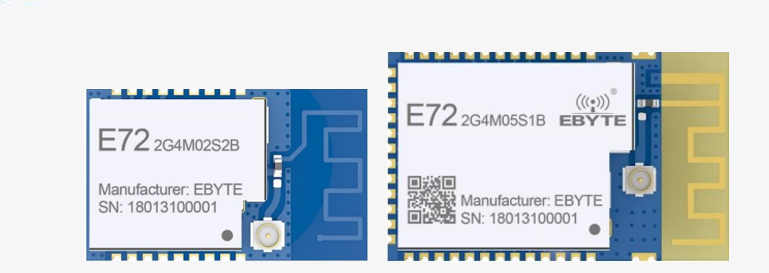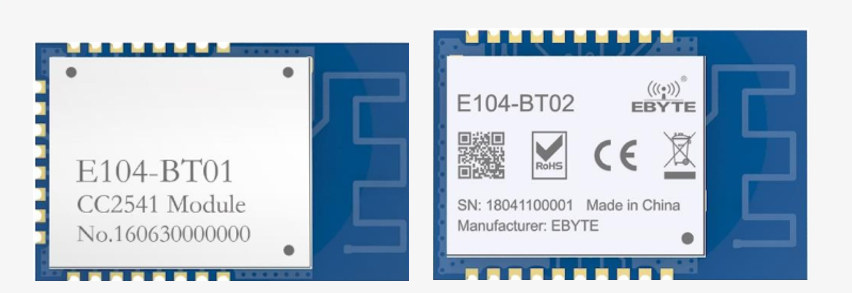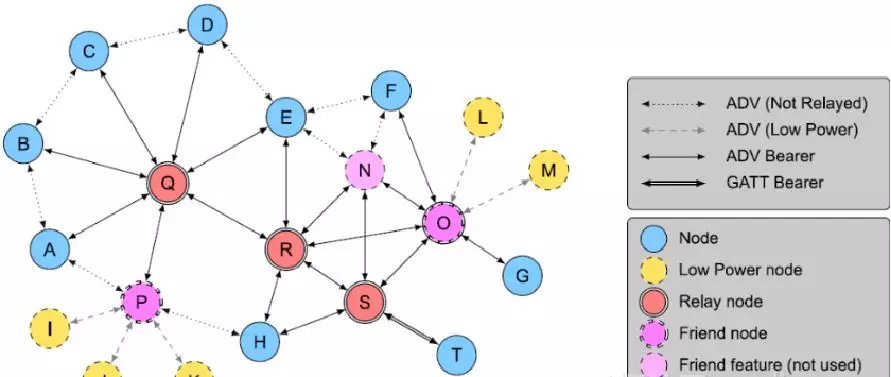
一、Bluetooth module classification
ESP-WROOM-32 | E72-2G4M02S2B |
E104-BT01 | E73-2G4M04S1A |
二、Specific attribute characteristics
1、 The difference between ESP-WROOM-32 and ESP32-WROVER

parameter | ESP-WROOM-32 | ESP32-WROVER |
Transmit power | 7.5dbm | 0dbm |
sensor | Hall sensor | Hall sensor |
Temperature Sensor | ||
interface | UART I/O | UART I/O |
Size | 18*25.5*2.8 | 18*31.4*3.5 |
2、The difference between E72-2G4MO2S2B and E72-2G4M05S1

parameter | E72-2G4M02S2B | E72-2G4M05S1B |
core | CC2640 | CC2640 |
Transmit power | 2dBm | 5dBm |
effective distance | 300m | 500m |
protocol | BLE4.2 | BLE4.2 |
3、E73-2G4M04S1A E73-2G4M04S1B E73-2G4M04S1D Difference

parameter | E73-2G4M04S1A | E73-2G4M04S1B | E73-2G4M04S1D | E73-2G4M08S1C |
core | nRF52810 | nRF52832 | nRF51822 | nRF52840 |
Transmit power | 4dBm | 4dBm | 4dBm | 8dBm |
effective distance | 100m | 100m | 100m | 120m |
protocol | BLE4.2/5.0 | BLE4.2/5.0 | BLE 4.2/5.0 | BLE4.2/5.0 |
Kernel | ARMCORTEX-M4 | ARMCORTEX-M4F | ARM CORTEX-M0 | ARM® Cortex ® -M4 |
Size | 17.5*28.7mm | 17.5*28.7mm | 17.5*28.7mm | 13*18mm |
Type | SoC | SoC | SoC | SoC |
Comment:
Cortex-M0
The code density and energy efficiency of the lowest-powered ARM processor, the Cortex-M0, means it is a natural, cost-effective replacement for 8/16-bit devices in a variety of applications while retaining the tools of the feature-rich Cortex-M3 processor. And binary upward compatibility.
Cortex-M3
Offering higher performance and richer functionality The Cortex-M3, introduced in 2004, recently updated with new technology and updated configurability, is the mainstream ARM processor specifically developed for microcontroller applications.
Cortex-M4
Energy-Efficient Digital Signal Control The Cortex-M4 provides unparalleled functionality to integrate 32-bit control with leading digital signal processing technology to meet the market for energy efficiency levels.
4、The difference between E104-BT01 and E104-BT02
parameter | E104-BT01 | E104-BT02 |
core | CC2541 | DA14580 |
Transmit power | 0dBm | 0dBm |
effective distance | 70m | 70m |
protocol | BluetoothV4.0 | BluetoothV4.2 |
Size | 14*22mm | 14.6*21.9mm |
Type | UART | UART |
三、The difference between BLE 5.0 and 4.2
1、BLE 5.0 vs 4.2
A: [Transfer rate is increased by 2 times] Bluetooth 5.0 has increased the current transmission speed by 2 times. Bluetooth 4.2 has a maximum communication speed of 1 Mbps, while Bluetooth 5.0 has a maximum communication speed of 2 Mbps. |
B: [Transmission distance increased by 4 times] The coverage of the Bluetooth 5 standard is 4 times that of Bluetooth 4.2. Improve indoor positioning accuracy. |
C:[Broadcast mode information capacity increased by 8 times] Its broadcast communication capacity has been upgraded from 31 bytes of Bluetooth 4.2 to 255 bytes, and enhanced broadcast capability will bring better beacons to create more location-based indoor location services and navigation services. Data transmission is achieved without pairing and wiring, and indoor positioning accuracy is less than 1 meter. |
D:[Low-power consumption and compatibility with older Bluetooth versions] In response to the demand for mobile IoT, it consumes less power and is compatible with older Bluetooth versions. |
2、BluetoothV4.2 vs 4.0
A: [Data transmission speed is faster] Compared with 4.0, under the Bluetooth 4.2 standard, the data transmission speed between devices is increased by about 2.5 times, and the amount of data that the Bluetooth intelligent data packet can hold is about 10 times that of the previous one. |
B: [More secure] In addition, the security of Bluetooth 4.2 has also improved. Without the user's permission, Bluetooth signals will not be able to connect and track user devices, and intelligent positioning is not possible. |
C:[More powerful] On the other hand, the new standard also promotes the introduction of the Bluetooth standard in the IPv6 protocol. Bluetooth 4.2 devices can access the Internet directly through IPv6 and 6LoWPAN, and support low-power IP connections. |
四、Bluetooth role
1、Master
The Bluetooth module in master mode can search for surrounding devices and select the slaves that need to be connected. You can send and receive data, or you can set the MAC address of the slave connected by default, so that the module can be found and connected when the module is powered on.
2、Slave
The Bluetooth module in slave mode can only be searched by the host and cannot be actively searched. After the device is connected to the host, it can also send and receive data with the host device.
3、E72-2G4M02S2B
Multiple roles. In this mode, each module is in master-slave integration, that is, it can connect other modules or be connected by other modules.
4、E104-BT01
You can choose to work in the Bluetooth master, slave or observer role. Observer role: After the character is powered on, Bluetooth broadcast scanning will be performed automatically, and the serial port will output the broadcast packet information.
5、E104-BT02
Modules can be configured as master or slave roles
2、E104-BT10
A: E104-BT10 is designed and produced by Ebyte Electronic Technology Co., Ltd. |
B: It conforms to the sig mesh V1.0 standard Bluetooth mesh self-organizing network module, and the single network theory can accommodate up to 32767 node devices; |
C: After the device enters the network, it automatically remembers the network information, and the network access time is completed within 1 second. |
D: The mobile APP can be connected to the network by any node to realize remote control of the mesh network; |
E: It can easily realize intranet broadcast or transparent transmission of any fixed point data. The largest single packet data supports 80 bytes. |
F: It conforms to the sig standard HSL (H: Hue, S:Saturation, L:lightness) model and implements the lighting control application scenario with one click. |

A:[Node] The edge node in the entire mesh network has the ability to receive and send data, but does not have the relay function. |
B:[Low power node]: Low-power node. Due to the existence of the friend node, the low-power node does not need to always send or listen to the data packet on the broadcast channel. It only needs to query whether there is data on the friend node. (not supported at this time) |
C:[Relay node]: It is the core node of the network layer extended network coverage. After receiving the data packets sent by other nodes, it determines whether it needs to be forwarded according to the judgment condition of the network protocol. |
D:[Friend node]: The low power node can establish a friendly connection with the friend node. As the proxy node of the low powernode, when the data of the lowpowernode node is reached, it can be cached in the Friendnode, waiting for the low power node to query and obtain. |
E:[Proxy node]: A proxy node that can receive information through a bearer layer (broadcast bearer layer or GATT bearer layer) and resend messages through another broadcast bearer layer or GATT bearer layer. It plays a key role in the process of non-mesh low-power Bluetooth devices becoming members of the Bluetooth mesh network. The fundamental purpose of the proxy node is to perform bearer layer translation. |
五、provision and mesh
The types of equipment supported by our company's products are provision and mesh. | Provision node: is a special node node that is the initiator of the entire network. Also known as gateway. It joins unnetworked devices to the mesh network. The Provision node provides provision data to unassigned devices, including netkey, appkey, and the unicast address for each element of the device. |
Mesh node: Our company's mesh node is a set of four roles: node, relay node, friend node, and proxy node. It is convenient and quick in use. | |
This mesh networking module is divided into E104_BT10-G, E104_BT10-N, two models | |
E104_BT10-G (that is, the provision node), E104_BT10-N (that is, the Mesh node) | |
E104_BT10-G This is the initiator of the entire network. There is only one E104_BT10-G in the whole network. | |